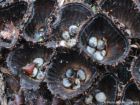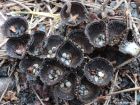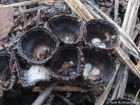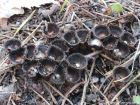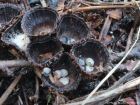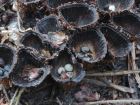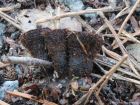Fruiting body begins as a fluffy, light-brown inverted cone and matures into a vase-shaped structure. As it ages, the pale lid that initially covers the opening falls away, often collapsing inside the nest to reveal four or five silvery, egg-like structures called peridioles. The outer surface of the nest is shaggy to woolly, grayish-buff to dark brown, and covered in tufts of fine hairs. In contrast, the inner surface is smooth, shiny, and distinctly fluted, an identifying feature reflected in both the species’ common name and its Latin epithet striatus. The peridioles, up to 2 mm wide, are ellipsoid to roughly triangular, sheathed, and attached to the nest by tiny cords known as funiculi. Spore print white.
Microscopic Features: Spores measure 15–20 x 8–12 µm and are ellipsoid in shape. They are smooth, have thick walls, and feature a distinct notch.
Cyathus striatus on the www.first-nature.com web site.
Cyathus striatus on the MushroomExpert.Com Web site.
Many mushrooms are poisonous, and some can be lethally toxic. Distinguishing between edible and poisonous mushrooms can be very challenging. Therefore, we strongly advise against consuming wild mushrooms. This website does not contain any information about the edibility or toxicity of mushrooms.
Although efforts have been made to ensure accuracy on this website, the information may contain errors and omissions. Therefore, all content provided is for educational and informational purposes only and should not be relied upon or used as a basis for consuming any plants or mushrooms.
External links are provided for reference only. We do not endorse or take responsibility for the content, advice, or products found on these sites or in any advertisements shown on this website.
